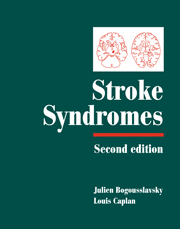Preface
Published online by Cambridge University Press: 17 May 2010
Summary
The success of Stroke syndromes over the 5 years elapsed since its publication is the reason for this second edition. Indeed, numerous comments made to us by colleagues, from trainees to international experts, have confirmed to us the interest and importance of a book deeply rooted in the clinical practice with stroke patients – especially in the era of starwars medicine aiming to help examination of these patients and facilitate diagnosis of their condition. The best compliment to medical teachers is when their work is liked by students and junior residents. However, we thought that there was room for improvement, and we have tried to reshape Stroke syndromes, so that some omissions have been filled, and so that it is still more user-friendly.
Besides, we have divided the initial book into two volumes, the first focusing on syndromes and their brain and vascular correlates, the second on the particular vascular etiologic syndromes which formed Part III of the first edition. However, the book, still meant as a guide, remains what it was, ‘a bound source and store of patterns and syndromes for non-experts in stroke to refer to when they encounter an unfamiliar pattern’, of three different types:
(i) patterns of symptoms and signs;
(ii) lesion patterns found in patients with infarcts and hemorrhages in various loci and various vascular territories;
(iii) patterns and syndromes that occur in unusual conditions that are known to cause stroke but that are not encountered very often.
- Type
- Chapter
- Information
- Stroke Syndromes , pp. xvii - xviiiPublisher: Cambridge University PressPrint publication year: 2001



